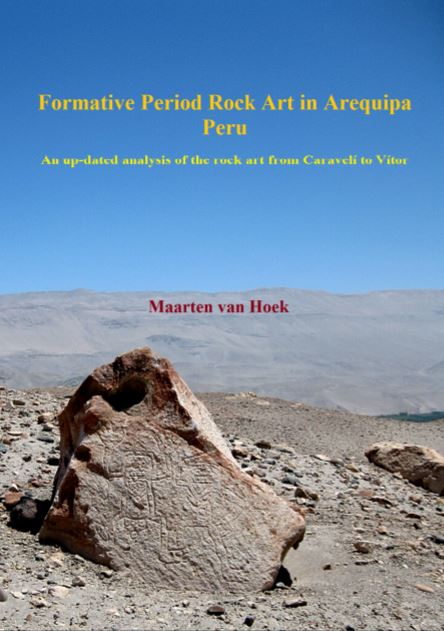(PDF) VAN HOEK, M. 2018. Formative Period Rock Art in Arequipa, Peru. An up-dated analysis of the rock art from Caravelí to Vítor. Oisterwijk, Holland.
This book deals with a group of valleys in the Department of Arequipa: from Caravelí to Vítor. The book (156 pages in English with 105 numbered illustrations [and many more]) - called Formative Period Rock Art in Arequipa, Peru. An up-dated analysis of the rock art from Caravelí to Vítor - offers many, previously unpublished illustrations of rock art panels that prove beyond any doubt that there certainly is a much larger amount of Formative Period rock art imagery in this area than previously accepted, including more MSC-Style petroglyphs. The book also discusses and rejects the authority of the purported Siguas Culture, as I argue that this specific, individual culture never existed. An important but still modest role in the creation of the many rock art layers in the Study Area is by the Paracas Culture, while the Wari Culture has had only very, very little impact. Finally, the study offers a tentative, up-dated Time Scale for especially the rock art of the Majes Valley. I hope that this up-date will be useful to a large number of rock art researchers in Peru and outside Peru.
Este libro trata de un grupo de valles en el Departamento de Arequipa: de Caravelí a Vítor. El libro (156 páginas en inglés con 105 ilustraciones numeradas [y muchas más]) - llamado Formative Period Rock Art in Arequipa, Peru. An up-dated analysis of the rock art from Caravelí to Vítor - ofrece muchas ilustraciones inéditas de paneles de arte rupestre que demuestran más allá de toda duda que ciertamente hay una cantidad mucho mayor de imágenes rupestres de Período Formativo en esta área que antes se aceptan, incluyendo más petroglifos al Estilo-MSC. El libro también discute y rechaza la autoridad de la supuesta Cultura Siguas, ya que sostengo que esta cultura individual específica nunca existió. Un papel importante pero aún modesto en la creación de las muchas manifestiones de arte rupestre en el área de estudio es por la Cultura Paracas, mientras que la Cultura Wari sólo ha tenido muy, muy poco impacto. Finalmente, el estudio ofrece una escala temporal tentativa y actualizada para especialmente el arte rupestre del Valle de Majes. Espero que esta actualización sea útil para un gran número de investigadores del arte rupestre en Perú y fuera del Perú.
Este libro trata de un grupo de valles en el Departamento de Arequipa: de Caravelí a Vítor. El libro (156 páginas en inglés con 105 ilustraciones numeradas [y muchas más]) - llamado Formative Period Rock Art in Arequipa, Peru. An up-dated analysis of the rock art from Caravelí to Vítor - ofrece muchas ilustraciones inéditas de paneles de arte rupestre que demuestran más allá de toda duda que ciertamente hay una cantidad mucho mayor de imágenes rupestres de Período Formativo en esta área que antes se aceptan, incluyendo más petroglifos al Estilo-MSC. El libro también discute y rechaza la autoridad de la supuesta Cultura Siguas, ya que sostengo que esta cultura individual específica nunca existió. Un papel importante pero aún modesto en la creación de las muchas manifestiones de arte rupestre en el área de estudio es por la Cultura Paracas, mientras que la Cultura Wari sólo ha tenido muy, muy poco impacto. Finalmente, el estudio ofrece una escala temporal tentativa y actualizada para especialmente el arte rupestre del Valle de Majes. Espero que esta actualización sea útil para un gran número de investigadores del arte rupestre en Perú y fuera del Perú.
MÁS INFORMACIÓN
- Video: Petroglifos de aves en el sur del Perú
- Video: ¿Aplacando los Apus? Petroglifos en Yarabamba
- Arte Rupestre / Rock Art de Van Hoek


No hay comentarios:
Publicar un comentario